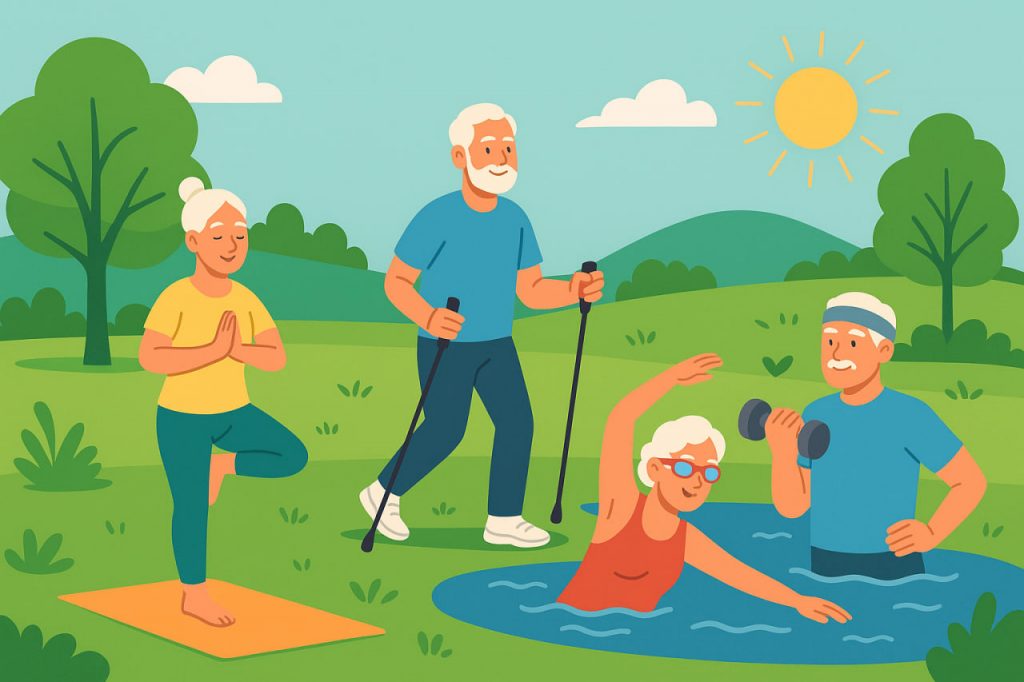Aging is a natural biological process characterized by gradual declines in cellular function, muscle mass, metabolic efficiency, and cognitive ability. While it cannot be stopped entirely, scientific evidence shows that regular physical exercise significantly slows the rate of functional decline and reduces the risk of many age-related diseases. Exercise affects nearly every physiological system, from the cardiovascular system to the brain, making it one of the most effective non-pharmaceutical interventions for healthy aging.
Muscle Preservation and Mobility
One of the most visible effects of aging is sarcopenia, or the loss of muscle mass and strength. Regular resistance training—such as lifting weights or using resistance bands—stimulates muscle protein synthesis, helping to preserve lean tissue even in older adults. Maintaining musculoskeletal integrity is critical for mobility, balance, and fall prevention.
Even light strength training can reduce the risk of frailty and disability in later years. Additionally, load-bearing exercise supports bone density, lowering the risk of osteoporosis and fractures. Thus, preserving physical function through movement directly supports long-term independence.
Metabolic and Cardiovascular Benefits
Physical activity improves insulin sensitivity, glucose metabolism, and lipid profiles, making it a critical tool in preventing type 2 diabetes and cardiovascular disease—two of the most common age-related conditions. Aerobic exercises like walking, swimming, and cycling enhance heart function and reduce blood pressure.
Regular cardiovascular activity also improves circulation, ensuring that oxygen and nutrients reach tissues efficiently. These effects not only support metabolic health but also reduce inflammatory markers associated with aging and chronic disease progression.
Cognitive and Neurological Protection
Aging is often accompanied by cognitive decline, but physical exercise has been shown to promote neuroplasticity—the brain’s ability to form new connections. Aerobic exercise stimulates the release of brain-derived neurotrophic factor (BDNF), a protein that supports neuron growth and survival.
Studies link regular physical activity with reduced risk of dementia, Alzheimer’s disease, and depression in older adults. Exercise also improves sleep quality, another essential factor for brain function and memory consolidation.
Cellular and Hormonal Effects
Exercise influences the body at the cellular level, slowing biological aging processes. It helps preserve the length of telomeres, the protective caps at the ends of chromosomes that shorten with age. Shortened telomeres are associated with increased risk of disease and early mortality.
Physical activity also helps regulate hormonal balance, including levels of cortisol, testosterone, and growth hormone, which affect tissue repair and energy levels. These adaptations enhance the body’s ability to recover and maintain homeostasis over time.
Immune Function and Inflammation
With age, the immune system becomes less efficient—a process called immunosenescence. Moderate regular exercise enhances immune surveillance, increases production of anti-inflammatory cytokines, and reduces chronic low-grade inflammation that contributes to degenerative diseases.
By reducing systemic inflammation, physical activity lowers the risk of a range of conditions, from arthritis to cancer. It also enhances the effectiveness of vaccines and the body’s ability to fight infections.
Conclusion
Physical exercise is a powerful, science-backed strategy for promoting healthy aging. By maintaining muscle mass, enhancing cardiovascular and cognitive function, and regulating inflammation and hormones, exercise slows the physical and biological signs of aging. Integrating consistent, moderate physical activity into daily life is one of the most accessible and effective ways to increase healthspan—the years of life spent in good health.
Glossary
- Sarcopenia — age-related loss of muscle mass and function.
- Insulin sensitivity — the body’s efficiency in responding to insulin, essential for blood sugar regulation.
- Neuroplasticity — the brain’s ability to form and reorganize synaptic connections.
- Telomeres — protective caps on chromosomes that shorten as cells divide.
- Brain-derived neurotrophic factor (BDNF) — a protein that supports neuron health and plasticity.
- Immunosenescence — the gradual decline of the immune system with age.
- Inflammatory markers — biological molecules indicating inflammation in the body.
- Healthspan — the portion of life lived in good health, free from serious disease or disability.


